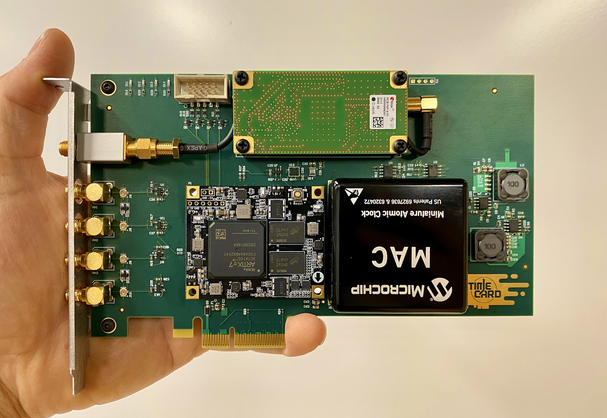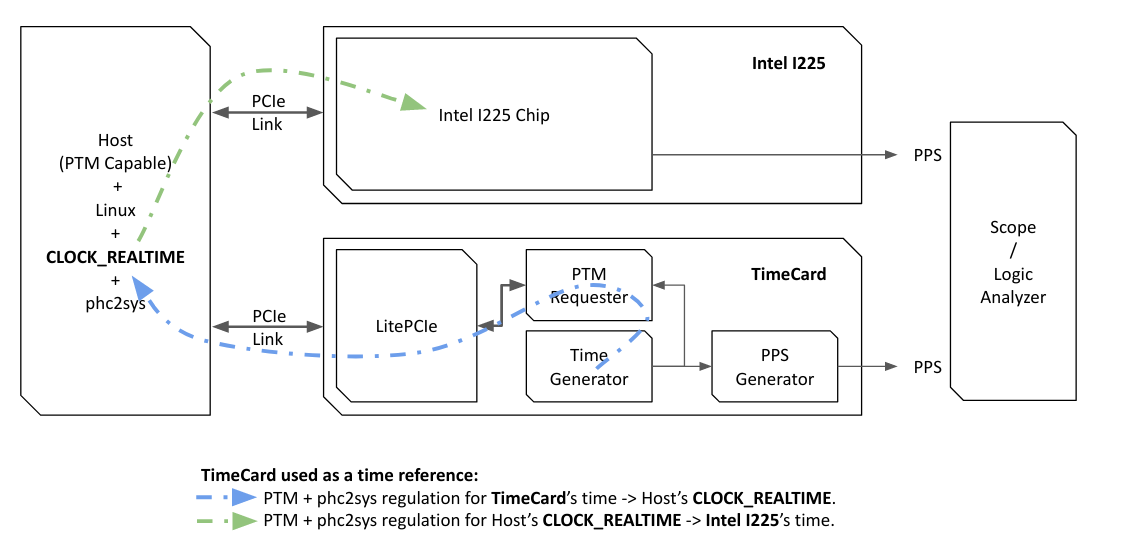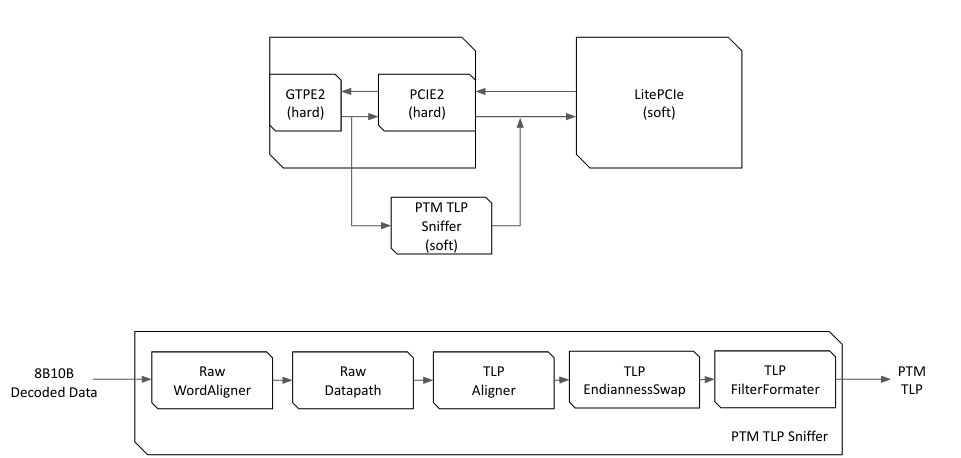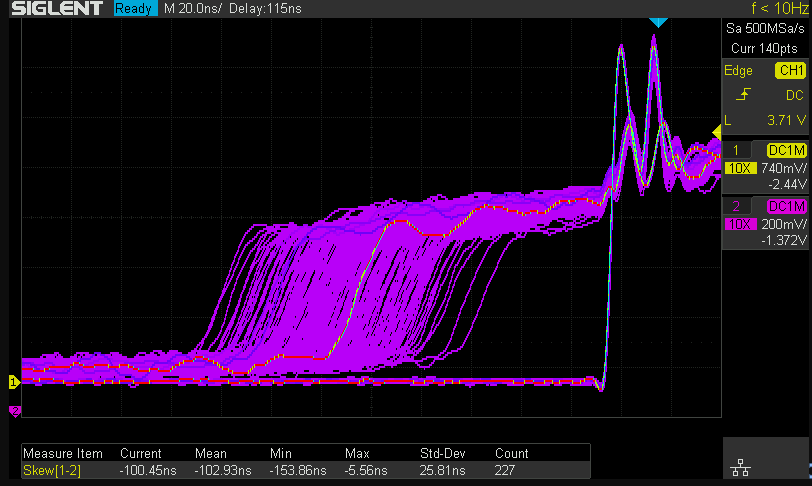__ _ __ ___ _________ ___ ________ ___
/ / (_) /____ / _ \/ ___/ _/__ ____/ _ \/_ __/ |/ /
/ /__/ / __/ -_) ___/ /___/ // -_)___/ ___/ / / / /|_/ /
/____/_/\__/\__/_/ \___/___/\__/ /_/ /_/ /_/ /_/
LitePCIe PTM support / test repository.
Copyright (c) 2023 NetTimeLogic
Copyright (c) 2023 Enjoy-Digital
The project provides PTM support/demo with LitePCIe on the TimeCard.
The FPGA board is configured as a PTM Requester and utilities/tests are provided to demonstrate correct operation.
To ease integration/maintenance, the PTM packet definitions and Packetizer/Depacketizer modules are directly integrated in LitePCIe.
This project provides:
- A PCIePTMSniffer module sniffing GTPE2 <-> PCIE2 traffic and generating PTM Responses. A PCIePTMInjector is not required since PTM Request are able to traverse the Xilinx PHY.
- A TimeGenerator module to generate a local time (in ns) and interface with the Linux driver.
- A PPSGenerator module to generate a PPS and allow external synchronization test with other PTM compatible boards.
- A LiteX design integrating LitePCIe with PTM support on the TimeCard.
- A Linux driver adding PTP/PTM support to LitePCIe driver.
- A demo application with phc2sys
As a demonstration of the work, an application has been prepared to synchronize the time of an Intel I225 Network Card to the time of the TimeCard through PTM/Linux/phc2sys utility with both boards generating a PPS and a logic analyzer/Scope observing the PPS:
These are required in order to build and use the FPGA design and associated software provided in this project:
- Linux computer, PTM capable (Tested with Ubuntu 20.04).
- Python3, Xilinx Vivado installed.
- LiteX installed and up to date (2023.09.22).
- An OCP-Tap TimeCard.
- An Intel I225 board.
- A JTAG-HS2 Cable.
- A Logic Analyzer/Scope to observe PPS.
From our understanding of the Xilinx PHY and question asked on Xilinx community forum, the Artix7's Xilinx PHY does not allow redirecting PTM TLP messages to the AXI interface. For a PTM Requester, this then prevent receiving the PTM Response/ResponseD TLP messages.
To work-around this limitation, a PCIePTMSniffer has been implemented: The module is sniffing the RX Data between the GTPE2 and PCIE2 hardblocks and descrambling/decoding the PCIe traffic to re-generate the PTM TLPs.
The re-generated PTM TLPs can then be re-injected in to LitePCIe core and use its PTM Depacketizer:
The Xilinx PHY however allow generating the PTM Requests from the AXI interface, so a PCIePTMInjector module hasn't been required.
Implementing the PCIePTMSniffer module required doing some hardware capture with Litescope of the GTPE2 <-> PCIE2 hardblock traffic. These raw captures have been used to create the descrambling/decoding logic and can be found in test directory.
These tests can be exectuted with:
$ python3 -m unittest test.test_raw_sniffer
$ python3 -m unittest test.test_tlp_snifferThe FPGA design can be build and tested with the following commands:
$ ./ocp_tap_timecard.py --csr-csv=csr.csv --build --load
$ Reboot the remote PC with the TimeCard.
$ litex_server --jtag
$ litescope_cli (for LiteScope use when design is built with a LiteScope analyzer probe)
$ ./test_time.py
$ ./test_ptm.pyLitePCIe's .yml configuration files can be reused and enabling PTM can be done by adding:
# PTM ----------------------------------------------------------------------
"ptm" : True, # Enable PTM support.The standalone core can be generated with litepcie_gen.py ocp_tap_timecard.yml and when generated with PTM support, will expose 3 additional input IOs:
- time_clk: The Clk used for time generation.
- time_rst: The Rst used for time generation.
- time_ns: The time in nanoseconds (Time that will be used for internal PTM T1/T4 time sampling
Enabling PTM adds a PTMRequester module to the design, with its own registers. The use is demonstrated in the provided Linux driver ('software/kernel').
A demo application allows time synchronization of an Intel I225 Network Card to the time of the TimeCard through PTM/Linux/phc2sys , with both boards generating a PPS and a logic analyzer capturing both PPS to check synchronization:
Start Host's CLOCK_REALTIME -> Intel I225's time regulation:
$ sudo /bin/bash
$ echo 1 > /sys/class/ptp/ptp0/pps_enable
$ echo 2 0 > /sys/class/ptp/ptp0/pins/SDP0
$ echo '0 0 0 1 0' > /sys/class/ptp/ptp0/period
$ sudo phc2sys -s CLOCK_REALTIME -c /dev/ptp0 -O 0 -mWith this, both the TimeCard and Intel I225 boards are generating their PPS, as can be seen unaligned:

Start TimeCard's time -> Host's CLOCK_REALTIME regulation:
$ cd kernel
$ make clean all
$ sudo ./init.sh
$ sudo systemctl stop systemd-timesyncd.service
$ sudo phc_ctl /dev/ptp2 set
$ sudo phc2sys -c CLOCK_REALTIME -s /dev/ptp2 -O 0 -N1 -mWith this, CLOCK_REALTIME is now disciplined on TimeCard, Intel I225 on CLOCK_REALTIME and
PPS are now aligned:
PPS edges have also been observed with a scope to evaluate aligment offset/jitter:
Regulation with phc2sys introduces most of the jitter, which could probably be reduced by fine tuning phc2sys's rate/KP/KI parameters.
An offset is also present and could be reduced to a minimal value by taking into account all hardware delays in the regulation chain:
- Time resynchronization delay between TimeGenerator and PTMRequester.
- PPSGenerator delay between TimeGenerator and PPSGenerator.
- PCIe PHY logic TX/RX delays.
- Clocks drift/phase.
Since TimeGenerator and PPSGenerator modules are minimalist and created just for this demo application, it will be more interesting to fine tune the offset/delays on the final application. The work done here and the demo should provide a good basis for this.
Inserting a glitch in the regulation and observe correct re-alignement can be done by simply changing the date of the system:
$ Ctrl-C on TimeCard phc2sys
$ sudo date -s XX:YY (a few seconds in the future)
$ sudo phc2sys -c CLOCK_REALTIME -s /dev/ptp2 -O 0 -N1 -m



